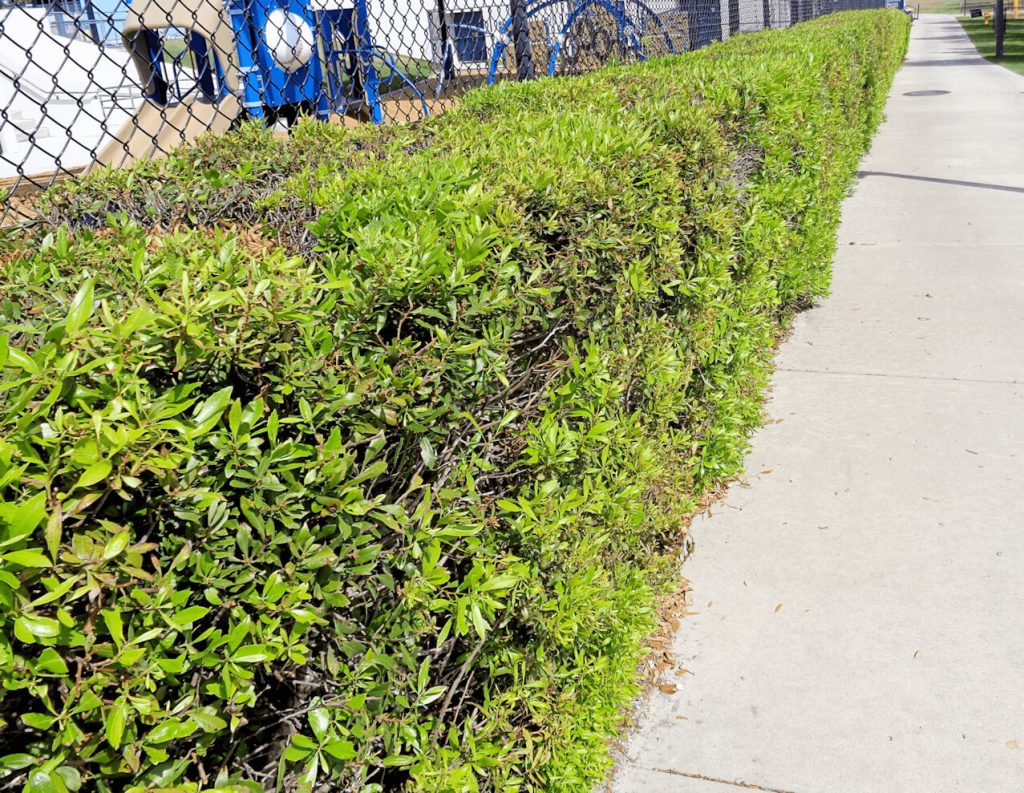By Ralph E. Mitchell

Do you like to use native plants in your landscape? If you do, the wax myrtle may be your plant. Useful as a plant for above ground planters, as a hedge, or as a small to medium-sized tree, the wax myrtle is a hardy woody plant that adapts well as a cultivated native.
As the name implies, wax myrtles have waxy berries (on female plants only), aromatic olive-green leaves, and light grey bark. This evergreen native is not only a popular landscape plant but is also attractive to wildlife because of the berries and cover. This tree is fairly rapid-growing up to twenty-five feet tall and can be maintained as a multi-stemmed small tree or an informal privacy screen. Planted in full sun to part shade, and from low, moist soils to high and dry sites, the wax myrtle is a very adaptable plant. Further, the high salt tolerance of this plant makes it a good coastal selection for difficult sites. There is even a cultivated variety named ‘Pumila’ which is a dwarf form of wax myrtle growing up to less than three-feet tall.
As with all landscape plants, make sure to water the wax myrtle transplant well until it is established. Keep in mind that only female trees have berries as long as there is a male plant in the vicinity for pollination. Wax myrtles have a habit of sending up sprouts from the roots which will need to be removed to keep the plant in a neat appearance. On the other hand, if you are looking for a good thick growth that offers wildlife habitat, these sprouts will be advantageous.
When planted in the groomed landscape, consider using the wax myrtle beneath overhead wires. As this woody plant tends to develop droopy branches, train by pruning as needed to maintain a more upright growth habit. Spaced about ten-feet apart, the wax myrtle can even provide some light shade. Wax myrtles also make ideal rain garden candidates as they do well in both seasonally wet and dry conditions.
For butterfly fans, the wax myrtle is a favored larval food of the red-banded hairstreak butterfly. Interestingly enough, the caterpillars of this butterfly are reported to feed on dead wax myrtle plants beneath the host plant.
One bad feature about the wax myrtle is its susceptibility to fungal wilt diseases such as Fusarium wilt, and lnonotus heartrot. Preventing root injury and avoiding over-fertilization with nitrogen fertilizer will reduce the chances of these diseases becoming a problem. Also be careful of pruning and use disinfected tools between cuts and between pruning different plants. One possible insect pest is the lobate lac scale, a relatively recent introduced pest, but I have only seen one case of it on wax myrtle in Charlotte County to date.
As wax myrtles are very flammable where wildfires are common, keep them a minimum of thirty-feet away from buildings for safety.
The use of natives like wax myrtle in the Florida landscape is beneficial and adds beauty and interest to any landscape – another Florida-Friendly Landscaping™ favorite! For more information on all types of Florida native plants to use in your landscape, or to ask a question, please visit https://www.facebook.com/CharlotteMGLifeline/. Ralph E. Mitchell is the Director/Horticulture Agent for the UF/IFAS Charlotte County Extension Service. He can be reached at 941-764-4344 or ralph.mitchell@charlottecountyfl.gov.
Resources:
Gilman, E. F. & Watson, D. G, Klein, R. W., Koeser, A. K., Hilbert, D. R. & McLean, D. C. (2018) Myrica cerifera, Southern Wax myrtle. The University of Florida Extension Service, IFAS.
Hall, D., W. & Butler, J. F. (2019) Red-Banded Hairstreak Calycopis cecrops (Fabricius 1793) (Insecta: Lepidoptra: Lycaenidae). The University of Florida Extension Service, IFAS.
Howard, F. W., Manon, A., Hodges, G. S., Steinberg, B., Mannion, C.M., McClean, D. & Wofford, J. (2017) Lobate Lac Scale. Featured Creatures, The University of Florida Extension Service, IFAS.
UF/IFAS Gardening Solutions (2021) Rain Gardens. The University of Florida Extension Service, IFAS.
Barnard, E. L. Diseases of Wax Myrtle in Floirda Landscapes – www.fdacs.gov/content/download/4633/file/…
The Florida-Friendly Landscaping™ Guide to Plant Selection & Landscape Design (2010) The University of Florida Extension Services, IFAS.
 0
0
